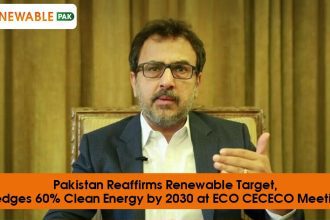Eco-Friendly Home Battery: Superdielectrics introduces the Faraday 2, a groundbreaking non-lithium battery that promises to revolutionize energy storage in homes. As recently green energy storage solutions are on the spotlight like Recent Finland’s Sand Battery likewise This eco-friendly home battery solution charges swiftly and is designed to significantly reduce your energy bills.
A Groundbreaking Eco-Friendly Home Battery for Energy Storage
Cambridge’s very own cleantech innovator, Superdielectrics, has proudly introduced Faraday 2, their cutting-edge aqueous polymer battery. Celebrated as a non-lithium battery, this eco-friendly home battery alternative promises rapid charging and budget-friendly, clean energy solutions for households.
Jim Heathcote, CEO of Superdielectrics, said: “The launch of Faraday 2 is a major step towards a low-cost and clean energy future, as well as a key enabler of global energy transition.”
This revolutionary technology represents a major advancement in home energy storage, aspiring to replace conventional lithium-ion systems with a more secure and eco-friendly home battery alternative.

Understanding How Faraday 2 Works: The Science Behind the Innovation
Building upon the legacy of its predecessor, Faraday 1, Faraday 2 takes a leap forward with its unique hybrid supercapacitor-chemical battery design. This advanced system features:
- Aqueous polymer membranes, drawing inspiration from contact lens technology
- A 3D hydrophilic polymer matrix that facilitates both electrochemical and electrostatic energy storage.
- Ion-selective barriers designed to boost overall efficiency.
- An eco-friendly home battery, water-based composition that eliminates the need for materials like lithium, cobalt, or cadmium.
According to Superdielectrics, Faraday 1 underwent an impressive testing phase of over one million hours, demonstrating its remarkable durability and long-term effectiveness in real-world applications.
Major Benefits of Choosing Faraday Batteries Over Lithium-Ion Alternatives
1. Eco-Conscious & Safe
The Faraday 2 boasts an eco-friendly home battery design free from harmful heavy metals; it’s non-flammable and constructed from easily accessible polymers, making it highly recyclable while posing a minimal fire risk. This is a critical feature for any truly sustainable battery substitute.
2. Rapid Charging
The Faraday 2 can achieve a full charge in about 30 minutes, outpacing lead-acid batteries by over ten times and surpassing the charging speeds of most household lithium-ion systems.
3. Longevity & Reliability
Thanks to its aqueous polymer system, this battery is anticipated to excel in terms of cycle life, showing remarkable resistance to degradation even after numerous charge cycles.
4. Affordability
With a foundation on abundant and low-cost materials, this battery has the potential to dramatically lower the cost per kWh of storage, providing substantial advantages for eco-friendly home battery option for energy storage, particularly in areas grappling with fuel poverty.
Data & Partnerships Driving Faraday 2’s Influence
Although the precise technical specifications for Faraday 2 haven’t been officially unveiled yet, preliminary field data from Faraday 1 shows great promise:
- Over 1 million hours of real-world testing.
- An astounding reported ninefold increase in energy cell density since 2022, as highlighted by interestingengineering.com.
- Collaboration with E.ON, which facilitates large-scale pilots to assess performance across UK households.
Julian Lennertz, Chief Commercial Officer at E.ON Next, remarked:
“Superdielectrics’ technology could be an essential component in creating a cleaner, more affordable energy future for everyone.”
These strategic partnerships are focused on refining Faraday 2 and getting it ready for extensive rollouts anticipated in late 2025.
Real-World Advantages: Essential Insights for Consumers
Slashing Energy Bills
Experience significant savings on your electricity costs! With quicker charging and deeper discharges, homeowners can make the most of their solar panels by shifting their energy usage to cheaper tariff hours.
Lower Carbon Footprint
By embracing renewable energy by harnessing and utilizing solar power on-site, households can decrease their dependence on grid electricity, supporting net-zero ambitions and bolstering climate resilience.
Minimal Maintenance & Durability
Designed for endurance, the Faraday 2 eco-friendly home battery promises exceptional reliability, perfect for home use without the need for frequent maintenance or replacement.
Challenges & the Path Forward
Faraday 2 holds great potential, yet key milestones remain:
- Need for Improved Specifications: Essential metrics, energy/power density, round-trip efficiency, and degradation rates require independent validation.
- Commercial Verification: Trials set for 2025 will reveal whether Faraday 2 can scale to meet consumer demands while matching the performance of lithium-ion batteries.
- Cost Competitiveness: Although it’s non-lithium, the anticipated long-term cost savings compared to lithium systems need to be demonstrated with real project data.
Superdielectrics intends to release more comprehensive findings by the end of 2025.
Expert Insights
Professor Marcus Newborough, R&D director at Superdielectrics, shares his thoughts: “The fusion of rapid charging capabilities with sustainability creates the opportunity for accessible and eco-friendly energy systems on a global scale.”
Meanwhile, Professor David Fermin from the University of Bristol hails the innovation as “a transformative development in energy storage,” praising its outstanding performance and environmental qualities.
The Importance of Faraday 2
- Expands the horizons of energy storage by moving beyond lithium technologies.
- Introduces rapid charging capabilities and recyclability into home energy solutions.
- Champions energy independence, making a difference for remote or off-grid residences.
- Has the potential to combat energy poverty by delivering affordable and clean energy to underserved communities.
Looking Forward: Launch and Its Impact
In collaboration with E.ON, Superdielectrics is setting its sights on home energy solutions in the UK, with plans to scale into Europe and beyond. The aim is to directly rival lithium-ion systems by introducing a non-lithium battery that emphasizes safety, affordability, and sustainability.
As pilot programs conclude later this year, anticipate comprehensive data on pricing, capacity, efficiency, and the environmental advantages. If Faraday 2 delivers on its expectations, it could transform home energy storage for the better.
Final Thoughts
Faraday 2 from Superdielectrics is showing to be a revolutionary and innovative solution in the realm of eco-friendly home battery alternatives. This fast-charging, non-lithium battery is not only safe but also fully recyclable and scalable. With comprehensive testing and robust partnerships in progress, it stands poised to disrupt the lithium-ion market in home energy storage.
If you’re an early adopter, a homeowner with solar panels, or just deeply invested in green technology, mark your calendars for 2025. That’s when the Faraday 2 is set to leap from a groundbreaking concept to a staple in households everywhere.












